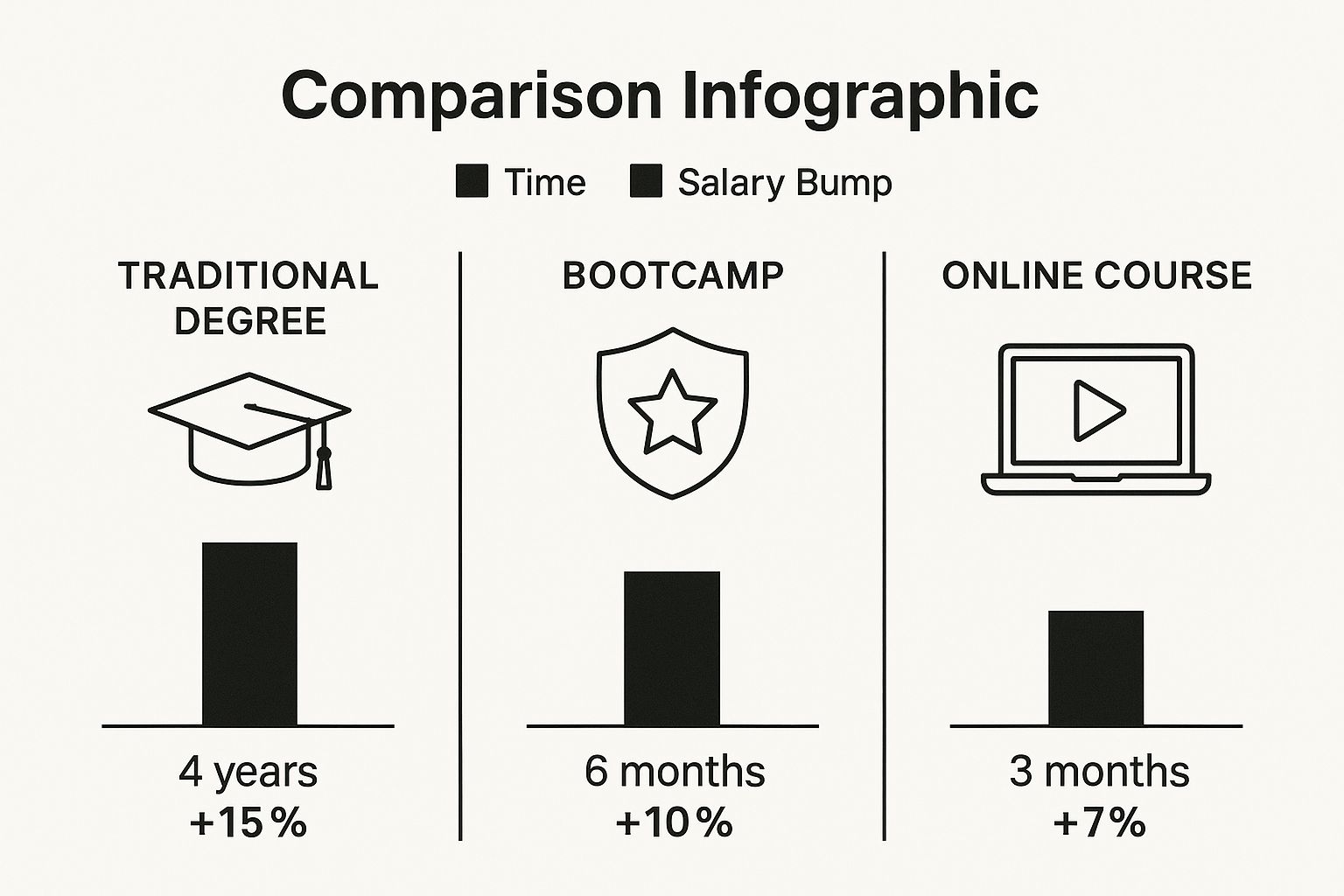Why Now Is the Perfect Time to Pivot Your Career

Changing careers was once seen as a drastic step, a final option. But today's job market embraces career pivots as a natural, even essential, part of our professional lives. This shift comes from a blend of economic, technological, and cultural forces that make this the ideal moment to explore a new direction.
The Rise of the Career Pivot
The growing number of career pivots isn't just a story; it's a fact supported by data. A striking 70% of workers are actively looking for a career change, with 57% aiming to switch in 2025. This desire for better work-life balance, more remote opportunities, and higher salaries drives this trend.
For many, the pursuit of higher pay is a key factor, with over 39% of career changers citing it as their main motivation. The struggle for work-life balance is also real, with 66% of Americans reporting difficulties in this area. This points to a significant portion of the workforce actively searching for more fulfilling and financially rewarding careers. Find more detailed statistics here: Career Change Statistics.
Technology is also reshaping industries at lightning speed, creating both obstacles and opportunities. This constant change requires individuals to adapt and gain new skills to stay ahead of the curve. This fuels a need for continuous learning and a willingness to consider new career paths. You might be interested in: How to Master a Site Map.
Embracing Change in a Dynamic World
Cultural shifts also contribute to the acceptance of career changes. The old idea of staying in one career for life is fading. There's a new focus on personal fulfillment and finding work that matches our values and passions. This shift empowers us to explore different career options and prioritize our well-being.
The rise of the gig economy and remote work offers greater flexibility and control over our careers. This freedom allows individuals to try new industries and work arrangements that better fit their lives and goals. It creates an environment where exploring different paths is not only okay but often encouraged. Even with a strategic pivot, skill gaps can feel overwhelming; here's how to focus on recovering from burnout.
Uncovering Your Hidden Transferable Superpowers

Your resume tells a story, but it doesn't tell the whole story. Beneath the surface lies a treasure trove of transferable skills, just waiting to be discovered and applied to a new and exciting career path. These skills are the core competencies you’ve cultivated throughout your professional journey. They transcend specific job titles and industries, forming the foundation for future growth. This section will guide you on how to identify, articulate, and harness these hidden strengths for a successful career transition.
Identifying Your Transferable Skills
Think of transferable skills as the engine driving your career forward, powering you through diverse roles and industries. They are the essential abilities applicable across various contexts. For instance, effective communication is vital whether you're a teacher, a project manager, or a graphic designer.
To begin uncovering these powerful skills, reflect on your past experiences. What did you genuinely enjoy doing? Where did you truly shine? This introspection will reveal recurring patterns, highlighting your natural talents and passions. Also, consider the positive feedback you’ve received from colleagues, supervisors, or mentors. Their perspectives can provide valuable insights into your unique strengths.
Categorizing and Demonstrating Your Skills
Once you’ve identified your transferable skills, it’s essential to categorize and demonstrate them effectively. This involves understanding how your abilities translate across different industries and showcasing them to potential employers. This is a crucial step in navigating a successful career pivot. To help you in this process, let's examine a few key skill categories.
To provide a structured approach to assessing your transferable skills, let's introduce a helpful framework. The following table outlines key skill categories, provides examples, suggests potential new industries where these skills are valued, and offers guidance on how to demonstrate them effectively.
The "Transferable Skills Assessment Framework" below provides a comprehensive structure for identifying and categorizing your transferable skills across different professional domains.
| Skill Category | Examples | Potential New Industries | How to Demonstrate |
|---|---|---|---|
| Communication | Writing, speaking, presenting, active listening, negotiation | Marketing, sales, public relations, customer service, education, healthcare | Portfolio of written work, presentations, testimonials, performance reviews highlighting communication effectiveness |
| Problem-Solving | Analytical thinking, critical thinking, creative solutions, decision-making, research | Technology, engineering, consulting, research and development, finance | Case studies showcasing successful problem-solving, projects demonstrating analytical skills, examples of innovative solutions |
| Leadership | Motivating teams, delegating tasks, strategic decision-making, conflict resolution, mentorship | Management, entrepreneurship, non-profit leadership, project management, team leadership | Examples of leading successful projects, testimonials from team members, descriptions of leadership roles and accomplishments |
| Adaptability | Learning new skills, embracing change, thriving in dynamic environments, resilience, flexibility | Technology, startups, fast-growing industries, consulting, project management | Examples of adapting to new technologies or processes, descriptions of navigating challenging situations, highlighting learning agility |
| Time Management and Organization | Prioritizing tasks, meeting deadlines, managing multiple projects, efficiency, planning | Project management, administration, operations, event planning, virtual assistant | Examples of successfully managing complex projects, testimonials highlighting organizational skills, demonstrating efficient work habits |
This framework empowers you to strategically assess and showcase your skills, making you a compelling candidate in your target industries. Remember to tailor the examples and demonstrations to the specific requirements of each role you pursue.
Building Your Skills Inventory
Creating a comprehensive skills inventory is vital for showcasing your unique value to potential employers. This involves documenting your key abilities with specific examples of how you've applied them in previous roles.
For example, instead of stating “strong communication skills,” provide concrete examples: “Developed and delivered presentations to executive leadership,” or “Successfully negotiated contracts with key clients.” This strengthens your claims, enabling hiring managers to visualize your potential contributions. This inventory becomes a valuable resource when crafting your resume, cover letter, and preparing for interviews. It’s a powerful tool that can open doors to exciting new career opportunities.
Finding Your Future-Proof Career Path

Career paths are not all the same. Some offer more stability and room to grow than others. When thinking about a career change, it's important to research industries and roles that match long-term market trends. This section will explore how to find promising career paths that give you both financial security and fulfilling work.
Identifying Future-Proof Industries
A critical part of a successful career change is picking an industry with a bright future. This takes research and careful thought. Look for industries that are growing because of new technologies or changes in what consumers want.
For example, the healthcare industry is always growing because people are living longer. Renewable energy is another promising area thanks to the world's focus on sustainability.
Technology creates both challenges and opportunities. Think about industries that are likely to thrive even with automation and other big changes. This can help you make a successful career change by matching your skills with areas that are growing and in high demand.
The World Economic Forum's Future of Jobs Report 2025 highlights this major impact. It predicts that 86% of employers expect AI and big data analytics to significantly change their businesses by 2030. While some administrative jobs might be lost, this shift will create a need for AI engineers, cybersecurity experts, and automation specialists.
Targeting Specific Roles Within Growing Industries
Once you've picked some promising industries, the next step is to look at specific jobs in those areas. This requires careful study of job market trends, what skills are needed, and salary expectations.
For example, healthcare needs more specialized nurses, physician assistants, and medical technicians. In technology, software developers, data scientists, and cybersecurity analysts are in high demand. Researching these roles can help you understand what skills you need and how you can advance your career.
Aligning Market Opportunities With Your Values
A future-proof career isn't just about following the latest trends. It's about finding opportunities that match your values and strengths. This means understanding what motivates you and the kind of work environment you enjoy.
Think about your transferable skills. How can you use those skills in different jobs or industries? Do you love solving problems? Do you enjoy working with other people? Knowing your values will help you choose a career path that offers financial stability and meaningful work.
This approach brings more job satisfaction and long-term career success. It makes changing careers a journey of self-discovery and professional growth. This way, you're not just getting a job, you're building a fulfilling career.
Building Your Strategic Pivot Roadmap
Successful career pivots don't just happen. They are built through thoughtful planning and strategic action. This section will guide you through the process of breaking down your career transition into manageable phases, creating a clear roadmap to your new professional destination. Learn to define your pace, sequence your activities, and cultivate the resilience needed for a smooth and successful career change.
Defining Your Pivot Pace
How quickly you transition depends on your individual circumstances, including finances, family commitments, and industry requirements. Some people can make a rapid switch, while others need a more gradual shift. This is where a personalized pivot roadmap becomes indispensable.
If you have significant savings or a supportive partner, a faster transition, perhaps through an intensive bootcamp or full-time education, might be possible. However, those with greater financial responsibilities might prefer a part-time approach. This allows for gradually acquiring skills and building a network while maintaining some income. You might be interested in: Learn more about our sitemap.
Your target industry also plays a key role. Highly technical fields often require more extensive training, while other industries might allow for faster transitions with demonstrable skills and experience. Choosing the right pace is crucial for minimizing risk and keeping your momentum throughout your pivot.
Sequencing Your Transition Activities
A successful career pivot requires a well-defined sequence of activities. It’s similar to building a house: you wouldn't start with the roof before the foundation. Certain transition activities naturally come before others.
-
Assessment and Exploration: Begin by honestly assessing your current skills, identifying your true interests, and exploring potential career paths. This foundational step sets the direction for your entire pivot journey.
-
Skill-Building: Next, focus on acquiring any new skills you need through focused learning. Consider online courses, bootcamps, or formal degree programs.
-
Networking: Start building connections in your target industry early. Attend industry events, conduct informational interviews, and leverage online platforms like LinkedIn.
-
Job Searching: Once you have the necessary skills and a growing network, begin actively applying for jobs and going on interviews.

The infographic above illustrates the relationship between time commitment and potential salary increase for three different learning paths: a traditional degree, a bootcamp, and an online course. A traditional degree offers the highest potential salary increase (+15%), but requires the longest commitment (4 years). Bootcamps and online courses provide faster routes to a salary bump (+10% in 6 months and +7% in 3 months, respectively), but with potentially smaller overall increases.
This structured approach helps ensure a smooth and efficient transition. It allows you to build on each step, maximizing your chances of success.
To further illustrate the different approaches, consider the following comparison:
To further understand the various transition approaches and their implications, let's look at a comparison table:
Understanding the different approaches can help you tailor your pivot strategy to your specific needs and circumstances.
Career Pivot Timeline Comparison
Different approaches to career transition timing based on financial readiness, industry requirements, and personal circumstances.
| Transition Approach | Timeline | Financial Requirements | Best For | Potential Challenges |
|---|---|---|---|---|
| Direct Switch | Immediate – 3 months | High (savings needed) | Individuals with in-demand skills and a strong network | High risk, potential for income gap |
| Part-Time Pursuit | 6 months – 2 years | Moderate (can maintain some income) | Individuals with financial obligations needing flexibility | Requires significant time management and dedication |
| Full-Time Education/Bootcamp | 3 months – 4 years | High (tuition and living expenses) | Individuals seeking significant skills upgrade or career change | Requires upfront investment and time commitment |
This table provides a quick overview of the different career pivot timelines. Choosing the right approach is a personal decision based on your unique needs and resources.
Building Resilience and Managing Expectations
Changing careers can be challenging. It requires resilience and realistic expectations. There will be setbacks and moments of doubt. Viewing these as learning opportunities, rather than failures, is crucial.
Develop coping mechanisms for stress and discouragement. This could include exercise, mindfulness, or support from your network of friends and family. Remember, career transitions rarely follow a perfectly straight line. Embrace the unexpected turns as valuable parts of the journey. Celebrate small wins along the way! Acknowledge each milestone you reach – whether completing a course, conducting an informational interview, or receiving a job offer. This positive reinforcement will keep your momentum going and build confidence throughout your pivot process.
Building Your Bridge to a New Industry
Networking is essential for any career, but it’s especially critical when changing industries. This section explores how successful career changers strategically build relationships in their target industries before applying for jobs.
Informational Interviews: Unlocking Hidden Insights
Informational interviews are invaluable for gaining insider knowledge. These aren't job interviews; they're conversations about a specific industry, role, or company. Reach out to people in your target field and request a short chat about their experiences. Prepare thoughtful questions beforehand.
Focus your questions on their career path, the industry's challenges and opportunities, and essential skills. For example, ask, "What are some common misconceptions about this industry?" Or, "What advice would you give someone starting out?"
These conversations offer priceless insights and can lead to unexpected connections and opportunities. You might be interested in: Learn more about our sitemap.
Networking Events: Making Meaningful Connections
Industry events, conferences, and workshops provide excellent opportunities to connect with professionals. However, just attending isn't enough. Prepare a concise elevator pitch summarizing your background and career goals.
Focus on your transferable skills and genuine interest in the industry. Approach conversations with authenticity, not desperation. Ask open-ended questions and listen actively. Follow up with new contacts afterward, referencing specifics from your conversation. This demonstrates genuine interest and strengthens the connection.
Digital Networking: Leveraging Online Platforms
Online platforms like LinkedIn offer powerful networking tools. Connect with professionals in your target industry, join relevant groups, and participate in discussions. Share insightful content related to your field and engage with others' posts.
A compelling transition story is key to digital networking. This narrative explains your career pivot, highlighting transferable skills and your new industry passion. Your story should make the change feel natural and intentional. A strategic roadmap for a startup can help formalize your direction, allowing you to define and implement your career change.
Maintaining Momentum: Nurturing Your Network
Building relationships requires time and effort. Don’t be discouraged if results aren’t immediate. Stay in touch with your contacts by sharing relevant articles, commenting on their posts, or sending occasional personalized messages.
Offer support or expertise whenever possible. This shows genuine interest and keeps you top of mind. By approaching networking with authenticity, strategy, and persistence, you can build a strong bridge to your new industry, unlocking hidden opportunities and accelerating your career pivot. This proactive approach significantly increases your chances of landing your dream role.
Filling Your Skill Gaps Without Breaking the Bank
The journey of changing careers often means learning new skills. From traditional degrees to online courses, the choices are many. But how do you choose the best investments for your new career? This section explores budget-friendly strategies to gain valuable skills.
Evaluating the ROI of Educational Options
Not every educational investment offers the same return. A traditional degree can be pricey and take years to complete. While valuable in some fields, it's not always the quickest route to a career change. Bootcamps offer intensive training in specific skills, often at a lower cost and in less time. Certificate programs provide focused credentials, showing expertise to employers. Self-directed learning, using online resources, books, and workshops, can be very affordable, but requires discipline and self-motivation.
Think about your desired field and research which credentials employers value most. Sometimes, a portfolio showcasing skills built through self-directed learning and projects might be more impressive than a formal degree. In other industries, certifications or bootcamp graduations can boost your credibility.
Formal Education vs. Practical Experience
Some skills are best learned through structured education, while others develop through hands-on experience. Technical skills, such as coding or data analysis, often benefit from formal instruction. Soft skills like communication, leadership, and problem-solving grow through real-world practice.
Try a combined approach. You might take an online course in project management and then volunteer to lead a project to apply what you've learned. This demonstrates both theoretical knowledge and practical application.
Showcasing Your Learning Journey
Share your progress even before you finish a formal program. Platforms like LinkedIn are great for highlighting courses, projects, and new skills. This shows initiative and commitment. Participate in online communities related to your field. Sharing your insights demonstrates your growing expertise and helps you network.
Leveraging Free and Low-Cost Resources
Many free or low-cost resources offer valuable learning opportunities. Platforms like Coursera, edX, and Khan Academy offer courses from leading universities and institutions. Libraries often provide free access to online learning platforms. Look for free workshops and webinars hosted by industry groups or professionals. These can be great ways to learn and network. By making smart use of these resources, you can gain valuable skills and show your dedication to learning without overspending.
Ready for the next step? Visit Henri Den for personalized guidance and resources to define your purpose, build your brand, and achieve lasting success.





